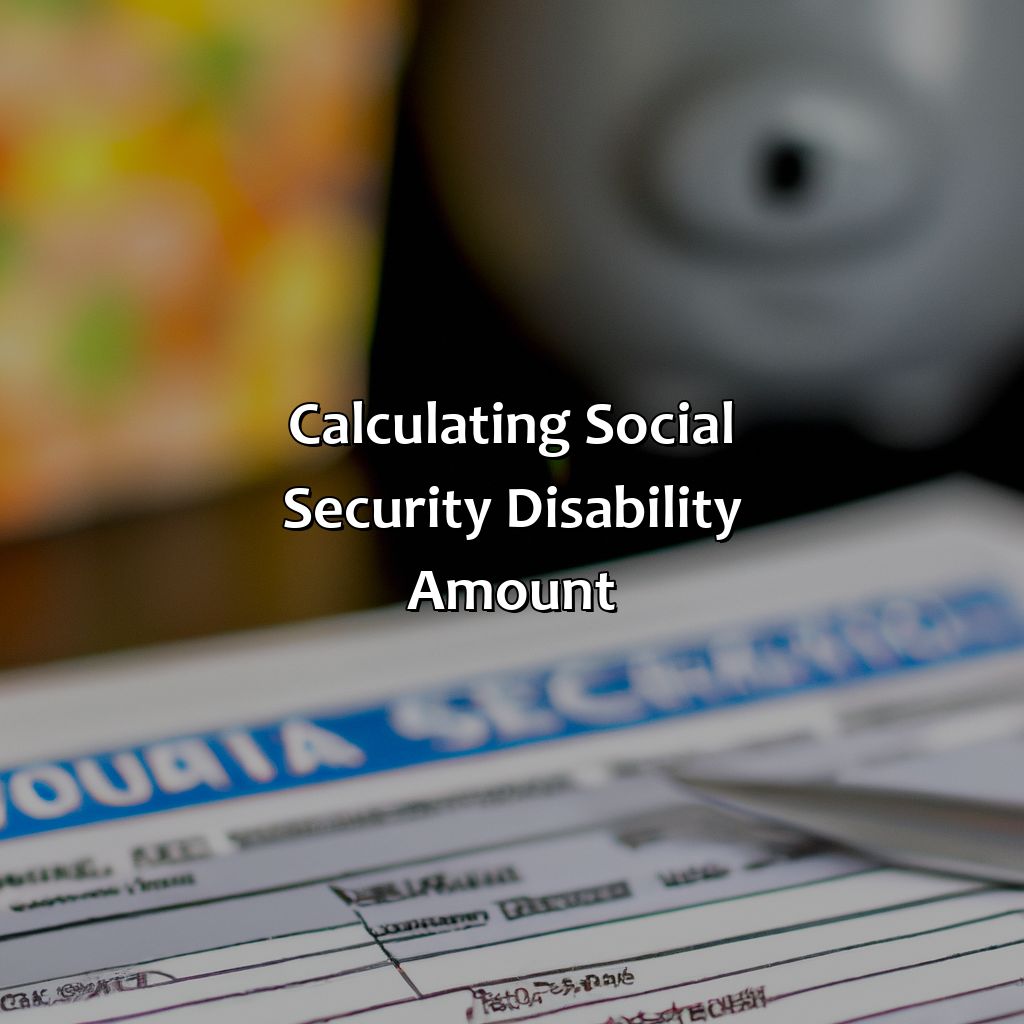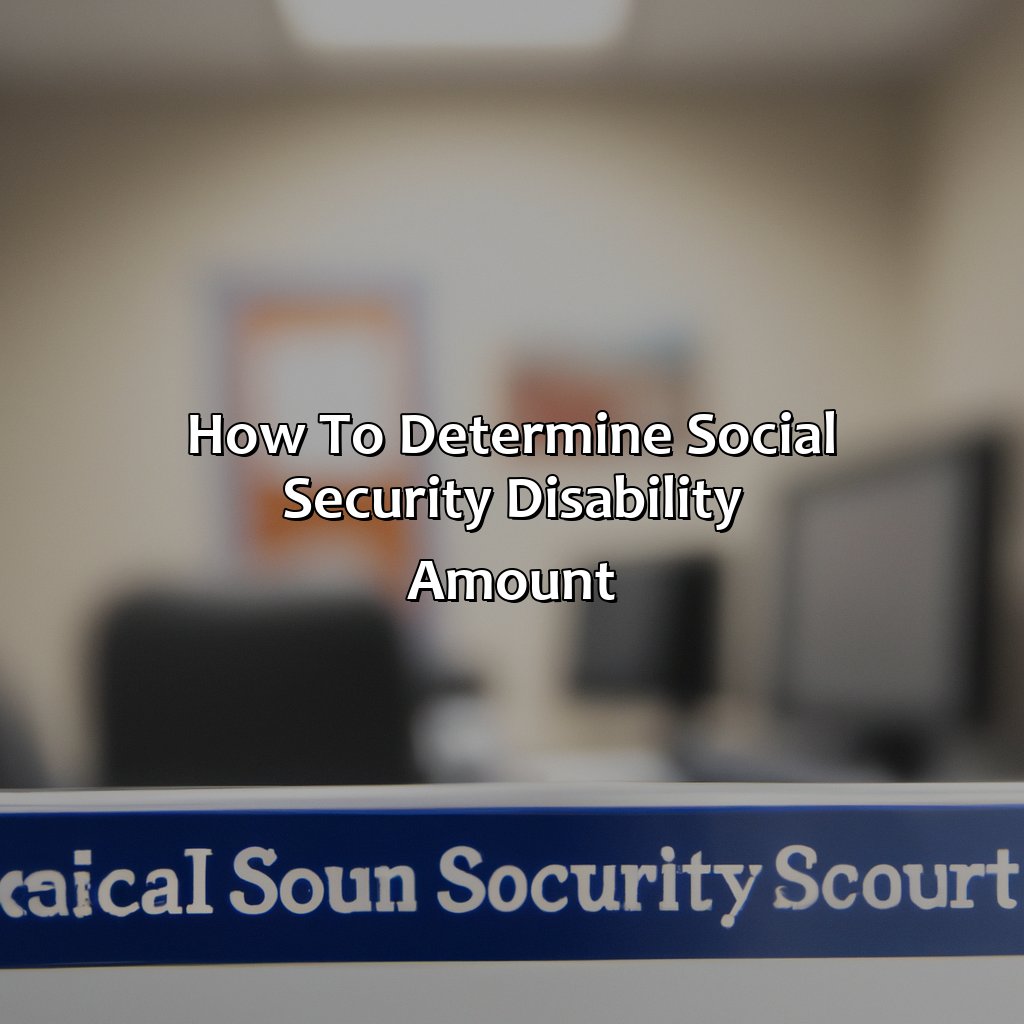How To Determine Social Security Disability Amount?
Key Takeaway:
- Determining eligibility for Social Security Disability benefits involves meeting both medical and work eligibility requirements, with a focus on proving that a medical condition prevents the individual from earning a substantial gainful income.
- The Social Security Administration calculates Social Security Disability benefits by using a formula that takes into account the individual’s primary insurance amount (PIA), average indexed monthly earnings (AIME), cost of living adjustment (COLA), and family maximum benefit (FMB).
- It is important to understand the factors that go into determining Social Security Disability benefits, as well as the application process and any potential appeals, in order to ensure that you receive the appropriate amount of benefits for your medical condition and work history.
Do you have questions about the Social Security Disability payment amount you may be entitled to? This article will help you understand how the amount is calculated and the factors that affect it. You’ll gain clarity and knowledge to ensure you receive a fair and accurate assessment.
Overview of Social Security Disability Benefits
In this article, we will explore how to determine the amount of Social Security Disability Benefits someone may be eligible for. Social Security Disability Benefits are a government program that provides financial assistance to individuals who are unable to work due to a disability. These benefits vary based on a few factors including the individual’s work history, age, and earnings, as well as the severity of their disability.
To determine the amount of Social Security Disability Benefits someone may be eligible for, the Social Security Administration (SSA) will first review the individual’s work history and earnings. If they have worked long enough and paid enough into Social Security, they may be eligible for disability benefits. Additionally, the severity of their disability will be reviewed to determine the amount of benefits they may receive.
It is important to note that Social Security Disability Benefits are not a one-size-fits-all program. The amount an individual may receive is unique to their specific situation and disability. The best way to determine the amount of benefits someone is eligible for is to consult with the SSA and review their individual case.
In order to increase the chances of receiving full benefits, individuals should ensure the accuracy and completeness of their application. This includes providing all required medical documentation and work history information. It is also important to stay in contact with the SSA and provide any updates or changes to their physical or medical status.

Image credits: retiregenz.com by Adam Woodhock
Determining Eligibility for Social Security Disability Benefits
To check if you can get Social Security disability benefits, you need to look at medical and work conditions. Here, we’ll explore the requirements for both and how they decide if you’re eligible. Medical eligibility and work eligibility are the solutions to understanding the Social Security Disability amount.

Image credits: retiregenz.com by Joel Arnold
Medical Eligibility
Assessing Medical Qualifications for Social Security Disability Benefits
Medical eligibility is a crucial aspect of applying for social security disability benefits. To determine whether an individual qualifies, the Social Security Administration evaluates their ability to perform work activities due to medical conditions. The medical conditions must be severe enough to limit the individual’s ability to perform daily activities and last at least 12 months or result in death.
A doctor’s assessment of the claimant’s medical condition serves as the primary source of evidence for evaluating medical eligibility. The doctor provides detailed documentation of the claimant’s diagnosis, treatment history, functional limitations, and any ongoing effects of the condition on their daily activities.
To evaluate medical eligibility, the Social Security Administration uses a five-step process that considers past work history, age, education level, transferable skills, and residual functional capacity (RFC). RFC determines what type of work activity an individual can perform despite their medical condition. If it is determined that they cannot perform any relevant job due to their physical or mental impairment, they may qualify for benefits.
Pro Tip: Providing complete and accurate information about your medical condition along with supporting documents will increase the likelihood of approval for social security disability benefits.
Looks like getting a job is easier than determining work eligibility for social security disability benefits.
Work Eligibility
Determining Work Eligibility for Social Security Disability Benefits involves assessing an individual’s ability to engage in substantial gainful activity due to a disabling condition. This evaluation considers the applicant’s past and current employment, education, skills, and residual functional capacity. If the applicant is unable to perform any work that exists in significant numbers in the national economy, they may be eligible for disability benefits. Additionally, their work history and contributions will determine the amount of monthly benefits they may receive.
It is important to note that Social Security Disability Insurance (SSDI) requires applicants to have earned sufficient credits by working and paying FICA taxes. The number of credits required depends on the age at which a person becomes disabled, but generally ranges from 20-40 credits with a minimum of 10 years of work history. People who do not meet these requirements may still qualify for Supplemental Security Income (SSI), which considers financial need rather than work history.
One example of determining eligibility would be evaluating a former construction worker who becomes disabled due to chronic back pain. The worker’s doctor provides medical evidence indicating limitations that prevent them from performing any jobs requiring heavy lifting or prolonged standing or sitting duration. An evaluator determines that the worker cannot perform any of their previous jobs due to their impairment and does not have transferrable skills to perform other jobs available in significant numbers in their region or nationwide. Therefore, they meet the criteria for Social Security disability benefits if they have sufficient credits based on their work history, and benefits amount will largely depend on their earnings record before becoming disabled.
Calculating social security disability amount is like trying to solve a Rubik’s Cube blindfolded – complicated and likely to give you a headache.
Calculating Social Security Disability Amount
Calculating your Social Security Disability sum? Grasp the key points! PIA, AIME, COLA and FMB are must-knows. To determine your Disability payments, you need to understand each detail. Get familiar with the ins and outs of these sub-sections. It’s essential for estimating your Social Security Disability amount.

Image credits: retiregenz.com by Adam Jones
Primary Insurance Amount (PIA)
The amount of money that one can receive from social security disability benefits is known as the Primary Insurance Amount (PIA). This amount is calculated depending on the average income earned in the past years and the number of years worked. The PIA is then used to determine the monthly payment an individual receives.
To calculate the PIA, the Social Security Administration (SSA) takes into account the earnings during a base period, which is typically 35 years. They apply a formula to these earnings called Average Indexed Monthly Earnings (AIME), which considers inflation and other factors. Once the AIME is calculated, a predetermined formula is applied to arrive at the PIA.
It’s essential to note that there are maximum and minimum limits to the PIA based on changes in inflation and other factors. Also, beneficiaries who start taking benefits before reaching full retirement age might receive reduced payments due to certain guidelines.
Individuals can increase their PIA by working longer or earning higher wages over their work-life. Furthermore, they can also opt for a spouse’s benefit or delay retirement until they reach full retirement age. All of these options may result in higher monthly payments. It’s crucial that individuals understand all their options before deciding when to claim Social Security Disability benefits.
Your AIME is like your ex’s salary, it determines how much you’ll be getting in the divorce from the government.
Average Indexed Monthly Earnings (AIME)
The AIME is the average wage index calculated over a fixed number of years and is used to calculate a person’s Social Security benefits. Here’s an overview of how to determine it.
To calculate your AIME, the first step is to identify up to 35 years of earnings that have been indexed for inflation. For example:
| Year | Income |
|---|---|
| 2020 | $45,000 |
| 2019 | $42,000 |
| 2018 | $39,500 |
| … | … |
Once you’ve determined your indexed earnings for each year in this time frame, you can select the highest-earning years and add them together. For example, if your highest-earning years were:
- 2020: $45,000
- 2017: $38,000
- 2015: $34,750
Your AIME would be calculated as follows:
((($45,000 /12) + ($38,000 /12) +($34,750 /12)) = $3,853.33
It’s essential to keep in mind that the formula used to calculate your Social Security benefits includes several other factors beyond the AIME.
Additionally, people who receive disability payments face numerous challenges in their lives every day. They do not give up on life despite their plight but face it with determination and courage daily.
A man named James could no longer work after suffering significant injuries in a car accident at the age of thirty-four. As he struggled with his financial situation and medical bills piling up during his recovery period, James sought help from Social Security Disability Insurance. Despite being initially denied twice, he persevered and finally received approval for his claim. His disability payouts now allow him access to much-needed medical care while giving him some relief from financial stress.
COLA: When the government gets to decide how much your Netflix subscription increases.
Cost of Living Adjustment (COLA)
The Cost of Living Adjustment (COLA) refers to the annual adjustment made to Social Security benefits to account for inflation and changes in the cost of living. This adjustment is aimed at ensuring that recipients’ benefits keep pace with the rising cost of goods and services.
COLA adjustments are calculated using the Consumer Price Index for Urban Wage Earners and Clerical Workers (CPI-W), a measure of the cost of goods and services that reflects spending behavior across various population groups. The COLA is typically announced in October, and payments begin in January of the following year.
It’s essential to note that not everyone who receives Social Security benefits gets a COLA adjustment. Those who receive Supplemental Security Income (SSI) do not receive COLA adjustments because SSI rates are calculated differently.
One way to maximize your Social Security Disability amount is by delaying payments until you reach full retirement age, which increases monthly payments by up to 30%. Another suggestion is working past your disability, since years where you don’t earn anything will reduce your benefit check when you retire.
Looks like having a big family pays off when it comes to Social Security Disability, thanks to the Family Maximum Benefit.
Family Maximum Benefit (FMB)
The maximum amount of Social Security benefits a family can receive is called the Highest Family Benefit (HFB). This comprises of a primary beneficiary and their dependents. The HFB is calculated based on the primary beneficiary’s full retirement age, individual benefit amount, and the number of dependents eligible to receive benefits.
It’s essential to note that the individual benefit amounts being received by members within the family may affect the total HFB available. In such cases where total benefits payable exceed the HFB limit, a proportional reduction is made for all recipients except for the primary beneficiary.
What’s unique about this calculation is that it doesn’t only consider one individual’s benefit amount but also factors in each dependent who qualifies for receiving Social Security Disability Insurance (SSDI) payments. An eligible dependent must be under 18 years of age or have become disabled before turning 22.
A young child was happy & proud after they turned 18 – it meant they could contribute money to help with household bills since their father became unable to work due to a disability. After learning about SSDI benefits, they asked their father if he claimed them which he wasn’t aware of. After applying for SSDI payments, they were given additional support through HFB-maximising by claiming all possible eligible individuals within their family.
Final Thoughts on Determining Social Security Disability Amount
To maximize your Social Security Disability benefits, it is crucial to understand how to determine your disability amount. You need to know what qualifies for disability benefits, how to apply for them, and the factors that determine your payment amount. The amount depends on your average lifetime earnings and your disability onset date. Your monthly payment will increase with your lifetime earnings, and the date of disability onset determines the amount of retroactive pay you receive.
To determine your Social Security Disability amount, start by understanding the eligibility criteria and application process. Once you have qualified for the benefits, ensure you have provided all your medical and financial records required for evaluation. It is also a good idea to hire an attorney to help you navigate the complicated application process.
Interestingly, Social Security Disability payments are also affected by your work history before you became disabled. The agency calculates your benefits based on your Average Indexed Monthly Earnings or AIME, which is determined by averaging your highest 35 years of income. Once your AIME is determined, it is adjusted for inflation and divided into three segments. The segments’ thresholds are then applied to calculate three different payment amounts, and your final benefit amount is determined by taking the weighted average of these three amounts.
Pro Tip: Be prepared to wait for a considerable amount of time before receiving your Social Security Disability benefits as the application process can take months or even years. In the meantime, try to cut down on your expenses and save money to make ends meet.

Image credits: retiregenz.com by David Jones
Some Facts About How To Determine Social Security Disability Amount:
- ✅ Social Security Disability benefits are determined based on your average lifetime earnings before your disability began. (Source: SSA.gov)
- ✅ The monthly benefit amount varies depending on the individual’s circumstances, such as their date of birth, disability onset date, and amount of past earnings. (Source: SSA.gov)
- ✅ The Social Security Administration uses a formula to determine the benefit amount, which takes into account the individual’s average indexed monthly earnings and the number of years worked. (Source: SSA.gov)
- ✅ The maximum Social Security Disability benefit amount varies each year and is adjusted for inflation. (Source: SSA.gov)
- ✅ In addition to Social Security Disability benefits, individuals may also qualify for Supplemental Security Income (SSI) benefits, which are based on financial need rather than work history. (Source: SSA.gov)
FAQs about How To Determine Social Security Disability Amount?
How is the Social Security Disability Amount Determined?
The Social Security Administration (SSA) determines the amount of Social Security Disability Insurance (SSDI) benefits you receive based on your average lifetime earnings before your disability began. The SSA takes into account your 35 highest-earning years to calculate your Social Security Disability amount.
Are there Minimum and Maximum Benefit Amounts for Social Security Disability?
Yes, the Social Security Administration sets a minimum and maximum amount for SSDI benefits each year. In 2021, the minimum benefit amount is $794, and the maximum benefit amount is $3,148.
Can the Amount of Social Security Disability Benefits Change Over Time?
Yes, the amount of Social Security Disability Insurance (SSDI) benefits can change over time. If your earnings increase or decrease, it can affect your SSDI benefits amount. Additionally, if you have a change in living arrangements or other factors that affect your eligibility, it can impact the amount you receive.
Are there Any Programs That Can Increase My Social Security Disability Amount?
Yes, there are certain programs that can increase your Social Security Disability Insurance (SSDI) benefits amount. For example, if you have dependent children, your SSDI benefits may increase. Additionally, the government may provide cost-of-living adjustments (COLA) that can increase your SSDI benefits amount each year.
Is it Possible to Estimate My Social Security Disability Amount?
Yes, you can estimate your Social Security Disability Insurance (SSDI) benefits amount by using the Social Security Administration’s online benefit calculator. This tool is designed to help you estimate your SSDI benefits based on your earnings history and age.
When Can I Begin Receiving Social Security Disability Benefits?
You can begin receiving Social Security Disability Insurance (SSDI) benefits as soon as you become disabled and your application is approved by the Social Security Administration. However, there is a mandatory five-month waiting period before you can receive your first SSDI payment.
